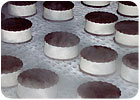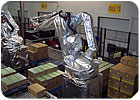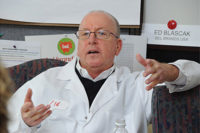
INDIANAPOLIS-The labeling of equipment, utilities and even fixtures within a processing plant is a crucial part of communicating the importance of employee safety. It’s one way to facilitate the type behaviors that lead to outstanding performance in terms of safety efficiency, and quality.
At Crossroad Farms Dairy, the Kroger Dairy Group’s sizable milk and ice cream plant, the messages from those labels reach employees and visitors before those individuals even reach the front door. A railing on the steps outside of the plant is labeled, encouraging anyone going up or down those steps to get a grip and watch their step.
The plant, one of the largest among the 19 production facilities in the Kroger Dairy’s portfolio, includes 18 lines that produce ice cream, novelties, milk and other beverages. The 230,000 sq ft plant, serves major markets including the Indianapolis and Chicago areas for milk, and the entire national market for some of its ice cream products.
It is also an exemplary facility with regards to safety, productivity, and product quality. At one time it was a plant with a higher-than-average rate of injury accidents, but for several years it has been one of Kroger’s safest.
“It’s the most diverse plant we have in terms of its product lines in the Dairy Group,” says Art Shank, the group’s operations and technical services mgr. “Safety, Quality and Reliability are a big part of the culture here at Crossroad Farms as they are at all of Kroger’s plants.”
Crossroad Farms, located directly in Indianapolis, is 35 years old, but there’s really nothing old about it. Expansions and improvements over the years have included robotics and high-capacity storage facility and most recently, a new round-top cone line was added.
“The Indianapolis plant has for a long time been an important keystone in Kroger’s dairy operations,” says Mike Nosewicz, v.p. of dairy manufacturing for Kroger’s eastern division.
While Crossroad has long been an effective, efficient plant, its safety record was not always where it should have been.
“This plant, for a long time, struggled with safety,” says George Clark, general mgr. at Crossroad Farms. “For whatever reason, it was an uphill battle for while. But once we came on board with the continuous improvement program we became a leader in safety.”
That program referred to as SQR, for Safety Quality and Reliability, and the way Kroger associates have embraced it, has led to dramatic performance improves in all of the dairy division’s facilities (and, indeed in all facets of the corporation). But there is no place where it is more evident than at the Crossroad Farms plant.

A place in history
When Kroger completed the construction on the Crossroad plant in 1973 it was proclaimed the largest dairy plant in the world. When Kroger was selected as Processor of the Year in 1983 by Dairy Record, the Indianapolis plant was one of several that were featured. That article bore the headline: “Still Modern After all These Years.”And now that it’s more than 30 years old, Crossroad is still a crucial part of Kroger’s dairy operations, providing fresh dairy products to more than 150 Kroger stores in Indiana and neighboring markets and ice cream and other longer-life products to Kroger stores coast to coast (there are more than 2,400 of those nationwide).
The Crossroad plant is also a survivor, having been struck by two tornados in the last five years, one of which tore open the facility’s freezer.
“We are very proud of the way the folks at this plant came together after the tornados and did all they could to recover,” Shank says.

On the floor
Milk is received at Crossroads through four drive-through receiving bays. Once routine testing is done, the raw milk is loaded out from tankers and sent to one of eight silos that hold in excess of 285,000 gals total.There are four separate HTST systems, three for milk, and one for ice cream. Once milk is separated, recombined and pasteurized it is sent to one of six pasteurized storage tanks on a mezzanine level from where it can be gravity fed to the individual production lines.
For milk there are three 26 valve Federal fillers, and one 18 valve Federal filler for gallons and halves. The filler room was one of the first in the country designed with a hepa-filtration positive air displacement system to help ensure a hygienic filling environment.
Bottles are blowmolded on site with four blowmolding units.
For ice cream, the plant employs two half-gal rectangular fillers. For ice pop novelties there are three Vitaline 12 wide in-line machines.
For standard sandwiches there are two lines from Norse Dairy Systems. A sixth novelty line is used primarily for round Interbake sandwiches, made with either premium round wafers or chocolate chip cookies, and vanilla or cookies and cream ice cream. The sandwich filler on the Interbake line can be rolled out so the line can be set up for push-up style pop-up novelties.
For the round sandwiches the line can run more than 100 pieces a minute. The indivdual units undergo a five-minute cycle in a nitrogen hardening tunnel that hard-freezes the sandwiches before they are packaged. Those sandwiches are then packaged in a six-wide clear clamshell package that separates each piece. It is closed with a single-piece wraparound adhesive label that includes the brand and product information.
The cone line was installed (2004) in a separate room from the rest of the novelties operation. It uses a Hoyer freezer and an NDS filling system.
Ice cream is fed from the freezers in a continuous flow to the filler. The system is run on a PLC with a VDT control panel that is a few steps from the operator. Sleeves of 48 cones are fed into the filler by the operator and the system pretty much handles everything from there, until the wrapped cones head downstream.
The sleeves are configured with eight cones across and six deep as they enter the machine. Pneumatic controls move the filling heads into position and simultaneously coat the first rows of cones with chocolate coating. Ice cream is then deposited into the coated cones at the second position.
The cones travel about 50 feet through the blast tunnel and are then inverted and brought back through the tunnel. Along the way they are blasted with subfreezing air by a series of ammonia-chilled freezer coils. The entire trip takes about 20 minutes from the time they enter until they leave the tunnel.
Still inverted, the cones exit the tunnel a few inches below the point where they had entered. They are dipped in chocolate coating (and for some SKUs a nut coating), before being ejected in the wrapper.
The wrapper draws film material from roll stock to wrap and seal each cone. Once they are sealed the cones travel along a conveying system that bundles them for cartons of six or eight. They are inspected and oriented by hand before they are packed into cartons with an automated cartoner.
All frozen products are eventually sent to a robotic palletizing room in the cooler that employs four robotic units. Each is sheathed in a insulated cover that allows it to operate in the sub-freezing conditions. The robotics were added in 2001, taking employees out of a difficult and hazardous environment.
The cooler was expanded in 2003 and includes deep lane roll-in rack systems. The expansion resulted in an additional 6,500 ft of cooler space, and 32,300 ft of freezer space.

Go team
The improvements that have made Crossroad Farms a model plant for Kroger have been made in large part thanks to teamwork philosophy that Kroger has employed for decades, combined the SQR and continuous improvement programs that have been implemented more recently.What that means inside the plant on a day-to-day basis, is that employees at every level work together in cross-functional hometeams, and task-specific teams to track performance, identify obstacles and implement solutions.
Robert Jackson takes the lead role on the ice cream hometeam at Crossroad.
“Our hometeam meets once a week, and the goal is to provide a place where we can have discussions that are open and honest,” Jackson says. “We ask people to be brutally honest.”
Jackson describes the same kind of system that’s iterated by top-level executives, and facilities managers. First, problems or situations, or opportunities are identified and evaluated. Next an individual or group is assigned responsibility for follow through. Then scorecards keep track of progress and timelines are set for meeting particular goals to address the given situation or opportunity.
The system empowers employees to improve conditions and performance relative to the three tiered imperative of Safety, Quality and Reliability.
“There’s pass up and pass down at each meeting to make sure that everyone is on board,” says Ron Fishback who heads a team that’s specifically for the Interbake line operators.
Darrell Childress works on a team that’s focused on the Behavioral Accident Prevention Process (BAPP).
“We do observations of one another, to see if safe behavior is taking place,” Childress explains. “Every employee, from our general mgr. down has to do two observations a month.
“It’s really become an important part of our culture. The focus is just to change those behaviors that aren’t safe.”
There are ten points of focus that the process identifies for reducing dangerous behaviors, and these include things like:
Walking around this plant, and others in the Kroger Dairy Group, concrete examples abound. Many of them are fairly fundamental like the installation of windows in swinging doors. Others go to the extent of equipment modifications, which bring tasks to the floor level, so that operators have less need to climb onto equipment or up steps or ladders.

Into the future
Crossroad Farms remains a tremendously vital and important plant to the Kroger Dairy Group, and all indicators point to its continued importance in the future. As its name implies it is ideally situated near the major transportation corridors that serve much of the country.Its performance achievements are second to none.
Kroger Going Organic with New ESL Line
HUTCHINSON, Kan.-A newly installed ESL line at a former ice cream facility is helping the Kroger Dairy introduce its own lines of organic milk and organic soy milk.The line was installed in a former ice cream room at the Jackson Dairy in September, after more than a year of planning says Tim Kelbel, V.P. of Dairy Manufacturing West.
“We know that organics is important to the Kroger Company and we wanted to be able to supply the company through the dairy group and have some critical mass and the benefits of extended shelflife,” Kelbel says.
The new line at the Jackson Dairy is centered on an Evergreen VTM 100 machine that is used primarily for half gals. It uses a UHT processing system and produces up to 120 cartons a minute.
“It’s a very nice system that really follows the industry standards,” Kelbel says.
It’s an excellent facility all the way around and we had some room where there used to be an ice cream operation, so it was the perfect place for it.”
The products are sold under two of Kroger’s house brands, Naturally Preferred Organic and Private Select Organic.
“As a company we are really trying to be more innovative in the area of product development,” Kelbel adds. “Organics is a growth area for us, and we always focus on our customers’ wants and needs.”
The company expects that the demand for these products will continue to grow, so the new operation was laid out with space for the addition of a second line.
